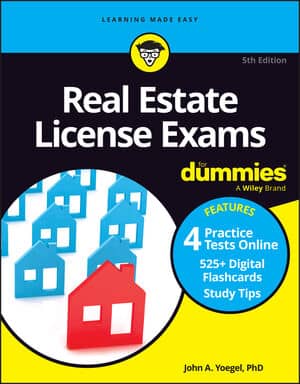A zoning ordinance, which in some municipalities is called the zoning code, is a set of rules covered on the Real Estate License Exam that control what property in the municipality can be used for and regulates where on the land any buildings will be located, the maximum height of the building, and the amount of land it can cover.
The zoning code essentially tells you what you can build, where you can build it, and how much you can build, all by designating zoning districts and establishing specific regulations for each district. A zoning district is an area that’s designated for a certain type of use — housing, shopping, and so on.
Typically a zoning ordinance divides a community into different districts for residential use, commercial use, agricultural use, and industrial use. Several districts may be designated in each of these categories.
Variances in zoning
Most zoning ordinances recognize unusual circumstances that require a certain degree of flexibility in applying zoning regulations. A one-property variation from the requirements of the zoning ordinance is called a variance. Variances can be granted whenever an owner proves that a difficulty or hardship will result in an attempt to build on the land or show that existing zoning will deprive him or her of economic use of the land.
For example, a zoning ordinance requires that a building must be set back 50 feet from the front property boundary line, but because of a rock outcropping that extends deep into the land from the back of the lot, the 50-foot setback would be impractical. A variance may be granted, permitting the building to be built ten feet from the front boundary line rather than the required 50 feet
This type of variance is called an area variance. A use variance, on the other hand, permits a different use of the land. One example of a use variance is a house with two apartments in an area that’s zoned for single-family houses.
A state-specific item for you to look into is what board or agency grants variances in your state. Names like board of zoning appeals, planning and zoning board, or zoning hearing board are common, but be sure to check it out. Remember that a board in one locale may be a commission in another. You can probably get this information from your local building or planning department.
Special-permit use
Another type of variation from the requirements of the zoning ordinance for an individual piece of property, in some places, is called a special-permit use; in other places, it’s called a conditional-use permit and in some places it may be called a special-use variance.
In any event, these variations are for uses listed in the zoning ordinance that are different enough from the permitted use within a zoning district that they require special review by municipal agencies. A nursery school in a residential neighborhood is an example of a use that may be appropriate in a residential zoning district but is different enough to make an additional review a good idea.
The municipality may want to require the nursery school to observe specific hours of operation or install special safety features before issuing the special-use permit. These permits generally are issued to a property owner and either run for the length of ownership or for a specified period of time.
Nonconforming uses
A nonconforming use refers to an established structure on or use of a piece of real estate that wouldn’t otherwise be permitted under current zoning. Nonconforming uses generally are buildings or uses that existed either when no zoning ordinance was in effect at all or when an old zoning ordinance was in effect that allowed such buildings and uses.
Perhaps your grandfather built a factory at the edge of town at a time many years ago when the area had no zoning ordinance. The factory continues to operate, but in the meantime, the town grew, and a zoning ordinance was adopted that zoned the area around the factory for single-family houses.
Although the specific regulations dealing with nonconforming uses vary from one place to another, the factory probably would be allowed to continue to operate. Typical regulations require the removal of the factory if it’s ever destroyed or closed for an extended period of time. The site of the factory probably wouldn’t be allowed to expand or change into another nonconforming use.
Accessory buildings and uses
Zoning ordinances sometimes allow accessory buildings and accessory uses on a piece of property.
Accessory buildings are buildings separate from the main building on a property that support or are related to the main building. A detached garage and a pool house are examples.
Accessory uses are uses that are related to but a little different from the principal use of the property. A separate apartment for a family member in a district zoned for single-family houses is an example of an accessory use. Accessory uses can be in the principal structure or in an accessory building.

